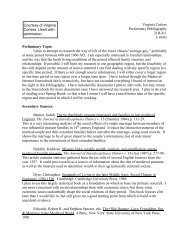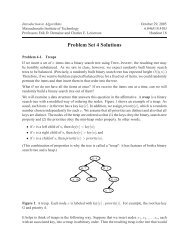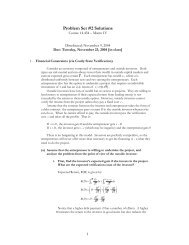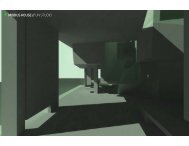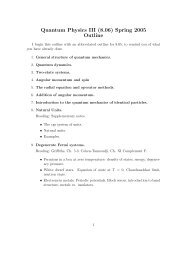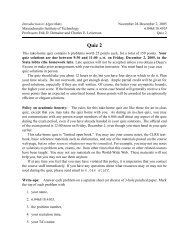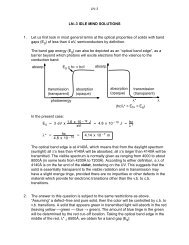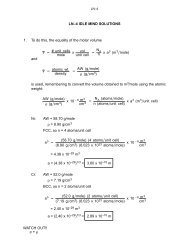DIFFUSION
DIFFUSION
DIFFUSION
You also want an ePaper? Increase the reach of your titles
YUMPU automatically turns print PDFs into web optimized ePapers that Google loves.
LN–93.091 – Introduction to Solid State ChemistryLecture Notes No. 9<strong>DIFFUSION</strong>* * * * * * * * * * * * * * * * * * * * * * * * * * * * * * * * * * * * * * * * * * * * * * * * *Sources for Further Reading:1. Shermon, P.G., Diffusion in Solids, McGraw-Hill (1963).2. Shaw, D., Atomic Diffusion in Semiconductors, Plenum (1973).3. Park, G.S., Diffusion in Polymers, Academic Press (1968).4. Ruoff, A.L., Materials Science, Prentice-Hall (1973).* * * * * * * * * * * * * * * * * * * * * * * * * * * * * * * * * * * * * * * * * * * * * * * * *1. <strong>DIFFUSION</strong>At any temperature different from absolute zero all atoms, irrespective of their state ofaggregation (gaseous, liquid or solid), are constantly in motion. Since the movement ofparticles is associated with collisions, the path of a single particle is a zigzag one.However, an aggregation of “diffusing” particles has an observable drift from places ofhigher to places of lower concentration (fig. 1). For this reason diffusion is known as atransport phenomenon.Figure 1 Mass transport, diffusion as a consequenceof existing spacial differences in concentration.In each diffusion reaction (heat flow, for example, is also a diffusion process), the flux(of matter, heat, electricity, etc.) follows the general relation:1
LN–9J (total) +*KDP xA +5x 10*8x7.9 x 10Dx3J = 3.9 x 10 –4 ??The units of the flux may be obtained from a dimensional analysis:cm 2 atm cm 2 cm 3J +*Kx DP xA + +Dx s @ atm cm 1 sThe total flux is 3.9 x 10 –4 cm 3 /s (with the gas volume given for 0°C and 1 atm). If thetotal gas flow by diffusion were to be determined for a specified time interval, thevolume would be multiplied by the indicated time.3. NONSTEADY STATE <strong>DIFFUSION</strong> (FICK’S SECOND LAW)The quantitative treatment of nonsteady state diffusion processes is formulated as apartial differential equation. It is beyond the scope of 3.091 to treat the equations indetail but we can consider the second law qualitatively and examine some relevantsolutions quantitatively.The difference between steady state and nonsteady state diffusion conditions canreadily be visualized (fig. 4). In the first case we have, for example, the diffusion of gasSteady state diffusionp1 = const.J = - K Δp/ΔxNon-steady state diffusionp 1Jp 2p 2 = const.membraneΔxΔp/Δx = constantFigure 4 Steady state and Non-steady state diffusionΔxΔp/Δx = f (time)from an infinite volume (P 1 const) through a membrane into an infinite volume (P 2const). The pressure gradient across the membrane remains constant as does the6
LN–9diffusive flux. In the second case we deal with diffusion from a finite volume through amembrane into a finite volume. The pressures in the reservoirs involved change withtime as does, consequently, the pressure gradient across the membrane.(You are not required to be familiar with the following derivation of the Second Fick’sLaw, but you must know its final form.)Consider a volume element (between x andJ x Jx+dx x+dx of unit cross sectional area) of aCmembrane separating two finite volumesFigure 5x x+dx involved in a diffusion system (fig. 5). Thex flux of a given material into the volumeelement minus the flux out of the volumeelement equals the rate of accumulation of the material into this volume element:J x * J x)dx+cdxt[c is the average concentration in the volume element and cdx is the total amount of thediffusing material in the element at time (t).]Using a Taylor series we can expand J x+dx about x and obtain:J xJ x)dx+ J x ) dx ) 2 J x dx 2 ) ...x x 2 2Accordingly, as dx → 0: D c +cx dx tand if D does not vary with x (which is normally the case) we have the formulation ofFick’s Second Law:c + D 2 c(Ficks Second Law)t x 2 7
LN–9In physical terms this relationship states that the rate of compositional change isproportional to the “rate of change” of the concentration gradient rather than to theconcentration gradient itself.The solutions to Fick’s second law depend on the boundary conditions imposed by theparticular problem of interest. As an example, let us consider the following problem(encountered in many solid state processes):A frequently encountered situation is the diffusion of a component 2 into an infiniteregion of a material 1 (fig. 6) [planar diffusion of doping elements into semiconductorsconc. of component 2c 2c ' 2Solid (1)c = f (t,x)(a)c 2, supplied through the gas phaseremains constantc 2conc. of comp.2Solid(b)c = c 2 erfc x / 2 Dtxc 2 ' = 0Figure 6 Diffusion at constant surface concentration ; bulk concentration of component2 at start of diffusion is c 2 ' (in a) and is zero (in b).xfor the generation of junction devices (p-n junctions, junction transistors)]. Theboundary conditions are: the concentration of component (2) at the surface of the solidphase (x=0) remains constant at c 2 and the concentration of component (2) in the solidprior to diffusion is uniformly c 2′ (a). Under these boundary conditions the solution toFick’s second law assumes the form:c 2* cc 2* c 2+ erf x 2Dt8
LN–9If no component (2) is originally in the solid matrix (1) (b), the above solution is simpler:c 2 * c + erf x c 2 2 Dt1 * c + erf x c 22Dtc + 1 * erf x c 2c + erfc x c 22Dt2Dtc + c 2 erfc x 2DtAn analysis shows that the last form of the solution to Fick’s law relates theconcentration (c) at any position (x) (depth of penetration into the solid matrix) and time(t) to the surface concentration (c 2 ) and the diffusion constant (D). The terms erf anderfc stand for error function and complementary error function respectively - it is theGaussian error function as tabulated (like trigonometric and exponential functions) inmathematical tables. Its limiting values are:erf (0) = 0erf (∞) = 1 And for the complementary error function:erf (-∞) = –1 erfc = (1 – erf)Another look at the above solution to the diffusion equation shows that theconcentration (c) of component (2) in the solid is expressed in terms of the errorfunction of the argument x2 Dt. To determine at what depth a particular concentration(c*) of (2) will appear, we substitute this concentration for (c) and obtain:c * + erfc x + Kc 2 2 DtSince the error function is a constant, its argument must also be a constant:9
LN–9c 2conc. of component 2c xc*Solid (1)t 1 t2t 3x + K2 Dtx xFigure 7 Advance of the concentration front (c*)as a function of trimeTherefore, under the given boundary conditions:x + K 2 Dtx + K Dtx T tThe depth of penetration of a specified concentration is found to be proportional to thesquare root of the time of diffusion.4. SELF-<strong>DIFFUSION</strong>As previously indicated, the thermal motion of atoms in a lattice is a random processand as such will lead to local displacements of individual atoms. This randommovement of atoms within a lattice (self-diffusion), which is not associated with anyexisting concentration gradients, can be readily demonstrated with the aid of“radioactive elements”. For example, nickel appears in nature in the form of several“stable isotopes”:10
LN–9mechanism whereby atoms simply change places with each other has to be excluded.More reasonable mechanisms were suggested by Frenkel and Schottky. Theyproposed the existence of point defects (vacancies) in crystals which provide amechanism by which atoms can move (diffuse) within a crystal. The concentration ofsuch vacancies, as you recall, can be calculated from simple statistical calculations.In most solids we are not dealing with single crystals but rather with polycrystallinematerials which contain a large number of grain boundaries (internal surfaces). Asexpected, the rate of diffusion along grain boundaries is much higher than that forvolume diffusion (D volume < D g-boundary ). FInally, surface diffusion, which takes place onall external surfaces, is even higher (D volume < D g-boundary < D surface ). The respectiveactivation energies for diffusion are:E a surface < E a grain boundary < E a volumeDiffusion in Non-MetalsIn non-metallic systems diffusion takes place by the same mechanisms as in metallicsystems. Oxygen, for example, diffuses through many oxides by vacancy migration. Incrystalline oxides and in silicate glasses as well, it is found that oxygen diffuses muchmore rapidly than the metallic ion. In glasses containing alkali atoms (Na + , K + ), therespective rates of diffusion are:D alkali > D oxygen > D siliconcorresponding to differences in bonding strengths. In polymer materials diffusionrequires the motion of large molecules since intramolecular bonding is much strongerthan intermolecular bonding. This fact explains that the diffusion rates in such materialsare relatively small.Gaseous Diffusion in SolidsSome gases, like hydrogen and helium, diffuse through some metals with ease even atroom temperature. Helium, for example, will diffuse through quartz and steel and limits12
LN–9the ultimate vacuum obtainable in ultra-high vacuum systems. Hydrogen similarlydiffuses readily through Ni at elevated temperatures. H 2 also diffuses at high ratesthrough palladium - a phenomenon which is used extensively for hydrogen purificationsince that material is impervious to other gases.13
LN–9TABLE 2The Error Functionz erf(z) z erf(z)0 0 0.85 0.77070.025 0.0282 0.90. 0.79700.05 0.0564 0.95 0.82090.10 0.1125 1.0 0.84270.15 0.1680 1.1 0.88020.20 0.2227 1.2 0.91030.25 0.2763 1.3 0.93400.30 0.3286 1.4 0.95230.35 0.3794 1.5 0.96610.40 0.4234 1.6 0.97630.45 0.4755 1.7 0.98380.50 0.5205 1.8 0.98910.55 0.5633 1.9 0.99280.60 0.6039 2.0 0.99530.65 0.6420 2.2 0.99810.70 0.6778 2.4 0.99930.75 0.7112 2.6 0.99980.80 0.7421 2.8 0.9999SOURCE: The values of erf(z) to 15 places, in increments of z of 0.0001, can be foundin the Mathematical Tables Project, “Table of Probability Functions . . .”, vol. 1, FederalWorks Agency, Works Projects Administration, New York, 1941. A discussion of theevaluation of erf(z), its derivatives and integrals, with a brief table is given byH. Carslaw and J. Jaeger, in Appendix 2 of “Conduction of Heat in Solids”, OxfordUniversity Press, Fair Lawn, NJ, 1959.14
LN–9EXERCISE FOR THE IDLE MIND1. Aluminum is to be diffused into a silicon single crystal. At what temperature will thediffusion constant (D) be 5 x 10 –11 cm 2 /s? (Given: E A = 315 kJ/mole and D o =1.70 cm 2 /s.)2. The diffusion constant of lithium in silicon is 10 –5 cm 2 /s at 1100°C and 10 –6 cm 2 /sat 692°C. What are the values of E A and D o for diffusion of Li in silicon?3. We know that in some nuclear reactors the probability of “fission” increases withdecreasing velocity of neutrons. For this reason we use, for example, graphite to“moderate” (slow down) neutrons; the neutrons diffuse through the graphite matrixand by collision are gradually slowed down. Do you expect the diffusion constant(D) of neutrons in graphite to be small (~10 –15 ) or large (~10 –5 ) as in liquids, oreven larger? Explain your answer.4. It is desired to diffuse In into pure silicon such that the In concentration at a depthof 3 x 10 –4 cm from the surface will be one-half of the surface concentration. Howlong should the silicon be in contact with In at 1600K in order to accomplish thisdiffusion? (D = 8 x 10 –12 cm 2 /s)5. A sample of Fe which has been “carburized” (carbon was diffused into it) at 930°Cfor ten hours has a “carburized” depth of 0.04 cm. How long must this same Fesample be carburized (exposed to carbon) to produce a carburized depth of0.08 cm?6. Suppose the average grain size of a solidified Cu-Ni alloy is 10 –2 cm. Each grainexhibits a lower Cu composition in the center than on the periphery. Approximatelyhow long will it take to eliminate the “coring phenomenon” (make the alloyhomogeneous) through high temperature solid state diffusion (by annealing) at1100°C. Given: D o = 2.7 cm 2 /s and E A = 235 kJ/mole.7. Indium (In) is to be diffused into pure silicon such that the In concentration at adepth (x) of 2.3 x 10 –4 cm below the surface will be one-half of the surfaceconcentration (maintained constant throughout diffusion). How long must diffusionbe conducted at 1600K if D = 8 x 10 –12 cm 2 /s?8Ga is diffused into a thick slice of silicon at a temperature of 1100°C for three (3)hours. What is, after that time, the Ga concentration (Ga/cm 3 ) at a depth of:(a) 1 x 10 –4 cm and (b) 3 x 10 –4 cm? (A constant Ga source is used at thesurface, C o = 10 18 /cm 3 ; D 1100°C = 7 x 10 –13 cm 2 /s.)15
LN–99. Determine the time of diffusion at 1600°C required to achieve an In (Indium)concentration of 3 x 10 17 /cm 3 at a depth of 8 x 10 –4 cm below the surface of asilicon wafer. [C o (constant) = 10 18 /cm 3 ; D 1600°C = 8 x 10 –12 cm 2 /s.]10. Indium diffusion into silicon is to proceed at 1600°C until the In concentration at adepth of 10 –3 cm is one-half of C o (the constant surface concentration). What isthe time of diffusion if D 1600°C = 8 x 10 –12 cm 2 /s?11. For small values of X the Gaussian error function (erf) can be approximated aserf(X) [ X. Suppose a silicon wafer is exposed to aluminum vapor at 1300°C andthe aluminum begins to diffuse into the silicon. How long will it take for theconcentration of Al at a point 0.01 cm below the surface to be 0.35 of that at thesurface? (D 1300°C = 10 –10 cm 2 /s.)12. A sample of steel which has been carburized at 930°C for ten (10) hours has acarburized depth of 0.04 cm. How long must this same steel be carburized at thesame temperature to produce a carburized depth of 0.08 cm?13. It is intended to market a new steel for automotive applications. This steel, to beeffective, is to have 20% of the surface concentration of Cr at a depth of 0.02 cmbelow the surface, to be achieved by diffusion at 1000°C. Determine if it iseconomically feasible to produce this steel, knowing that D o = 0.47 cm 2 /s andE A = 332 kJ/mole.14. Gallium is to be diffused for three hours at a temperature of 1375K into a thickslice of silicon. Given a constant surface concentration of gallium (C o = 10 18 /cm 3 )(D 1375 = 5 x 10 –13 cm 2 /sec), after that time what will be the Ga concentration at adepth of (a) 1 x 10 –4 cm and (b) 3 x 10 –4 cm?15. A metal exposed to air is found to oxidize according to a linear rate law. Uponaddition of aluminum (Al) as an alloying constituent, the same metal oxidizesaccording to a logarithmic rate law. Explain the oxidation behavior of the pure andthe alloyed metal.16. To increase its corrosion resistance, chromium is diffused into steel at 980°C. Ifduring diffusion the surface concentration (c s ) of chromium remains constant at100%, how long will it take (in days) to achieve a Cr concentration of 1.8% at adepth of 0.002 cm below the steel surface? (D o = 0.54 cm 2 /sec; E A = 286 kJ/mole)16



![18.03 Class 21, April 3 Fun with Fourier series [1] If f(t) is any decent ...](https://img.yumpu.com/51148985/1/190x245/1803-class-21-april-3-fun-with-fourier-series-1-if-ft-is-any-decent-.jpg?quality=85)

